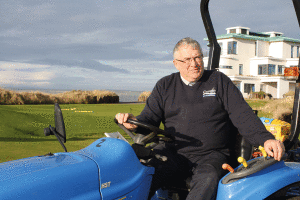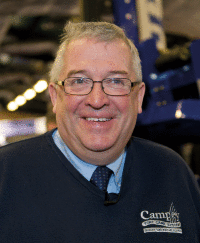Richard Campey - The Keynote Interview

He was responsible for pioneering the innovative Koro machines, which are now used extensively across all sports disciplines, and his company continues to source and supply unique products for the maintenance of natural turf.
He is a strong advocate of natural over artificial turf and remains concerned that the marketing of the latter is both unbalanced and unfounded, in many instances.
In this keynote interview, Richard discusses how his company grew from a regional dealership to become a major distributor, and his concerns over the natural versus artificial debate.
Is Richard Campey in a good place at the moment?
As good as we can be.
How long have you worked in our industry and what drew you to it?
Thirty-nine years on January 2nd 2015. I never knew the industry existed until I saw a job advert in the local paper for a local company called SISIS.
Tell us a bit about how the company has progressed over the past decade or so?
Over the last decade, we have expanded by taking more innovative products on board; these products have led us to a wider turfcare marketplace and, in some instances - Koro and Imants - worldwide. This has led to an increase in company personnel and more travelling. As a company, we are very lucky in being able to find staff who have knowledge and passion for the turfcare industry. However, these last five years have been tough, but we have persevered, and now have distributors and dealers set up worldwide for our products.

The knowledge that these products will go a very long way in helping to improve the quality of natural grass playing surfaces.
Is there anything new on the horizon you want to tell us about?
There are one or two products on the back burner that may come to fruition; you will all have to wait and see.
You seem to be always on the road conducting demo days. Do you see this as the best way to bring your products to market or do the industry exhibitions still have their place?
We feel that demo days still have a major place in making customers aware of what our products can do, and we are geared up to do these, staff and vehicle wise. Exhibitions still have a place; however, they seem to be going indoors and this means more expense. As some of our machinery takes up quite a bit of space, we much prefer to show products working. We may have up to fifty people at a demo and, often, customers may be interested in having a further demo on their site. Golf clubs are probably worse for this and expect to have use of machinery for a week. We are as good as anyone in allowing this, but what other industry would accept this scenario? Very few, I would suggest.
The natural v artificial debate is close to your heart. Can you explain why?
We have many, many good turf managers, both in groundsmanship and greenkeeping, who are providing excellent quality natural turf playing surfaces. However, artificial seems to get all the hype and exposure at present, at the expense of natural turf. That's marketing, I suppose!!!
Another fact is that most of the plastic carpets are made in China. We exhibited in Sao Paulo, Brazil last year, and spent three days looking at the Chinese Pavilion opposite, which was sponsored by the Chinese Government.
It consisted of ten Chinese plastic carpet manufacturing companies. All the companies present in the Pavilion were pedalling plastic grass that, if they had their way, would cover the world.
More importantly, the latest plastic pitches are filled with rubber crumb, which comes from synthetic car tyres. You mustn't forget that you are asking your kids to play on the very substance that, I am led to believe, could cause problems in later life.
There has been much concern over the health and safety issues surrounding 3G and the rubber crumb infill, much of it emanating from the USA. How much of this is fact based over conjecture?
Well, there are various articles published on this subject. Most are written by professionals, and who am I to query what they say? Have a read for yourself and then you decide.

Partly, but from the top down - FIFA, UEFA, FA, Sport England, Helen Grant MP, the Minister for Sport and Equalities - all the emphasis is being placed on plastic as if natural grass does not exist anymore. Properly constructed and maintained natural grass and/or hybrid natural grass, of which we will see more of in the future, can easily perform just as well as plastic, if not better.
Why should it go to litigation? Shouldn't common sense prevail? And, aren't some of these plastic manufacturers and installers part of big institutions?
Do you accept that one player suffering health issues is more newsworthy than 999 who have no issues?
It's not just one player, is it? If the plastic boys have their way, everyone will be playing on plastic, then who knows what the health issues will be, if those professionals highlighting the risks are right?
Would you like to see proper research undertaken here in the U.K. on the subject?
Yes, on both plastic and natural.
How much do you feel the marketing of 3G has run roughshod over natural turf?
To date, 100%.
Do you believe the natural turf camp has, to a degree, sat back and simply let this happen?
Yes, somewhat.
Rugby Union has pioneered 3G at the highest level at Saracens without too many complaints from the players and coaching staff, whilst many more rugby clubs look to be following suit. What is your view on these developments?
I'm lead to believe that players are not allowed to make detrimental comments about plastic due to the contracts between clubs and manufacturers.
Equally, the Football League was close to accepting 3G as a suitable surface in the recent split vote, whilst the FA's Greg Dyke and other industry bodies have come out in favour. These developments must be a worry?
I'm not sure if the FA still has the blinkers on. Do they not see the standards that groundsmen are achieving in the Football League, both at pitch and training academy level? With the knowledge, machinery and techniques that are available today, good, natural grass playing surfaces can be achieved at any level.

You can only pare back to the bone, and then you know that you cannot go any further. We have examples nearby of pitches not maintained at local authority level and neighbouring authorities who have invested in no more than £40,000 worth of machinery, who can keep grass on the pitch all year round and who have increased playing hours by over 25%.
The authority to which I pay business and domestic rates charge £145 per game, per pitch. Let's say - providing it does not rain - that they play for twenty-six weeks a year; one match Saturday and one match Sunday
Two a week = 3 hours x 26 = 78 playing hours/year
Or
52 matches at £145 = £7540 per pitch.
In the Netherlands, I know of a small local commerce serving a town of 15,000 where they have nine pitches, plus a grass running track. These are natural turf constructed/drained pitches, plus one 5-a-side plastic pitch (next to the clubhouse, which is only used in winter when the ground is frozen).
This is all maintained by one man with a 45hp tractor, trailer, fertiliser spreader, harrows, aerator and two linemarkers. He looks after these with the unpaid help of two OAPs who mark the pitch and empty litter bins.
The pitches are used for training after school by children aged from 5 to 16, and for the team training as well. Actual professional play, per year, is 270 hours per pitch.
= 180 matches per pitch x £145 (assuming they are paying the same as my local authority)
= £26,100 per year x 9 pitches
= £234,900 per year
For the outlay of one man's wage £45,000 plus £100,000 of equipment over 5 years = £20,000 plus materials and contractors for grass cutting, so let's say £134,900 per year.
A surplus £100,000 is put back into the community.
I don't know if this is happening anywhere in my country.
Artificial surfaces are often promoted as being all weather, maintenance free, good revenue streams etc., which are strong arguments, don't you agree?
In regard to all weather, we have heavy frosts and temperatures down to minus 10OC; you cannot play on a plastic pitch in these conditions. Similarly, in very high temperatures, the surface of plastic pitches can reach in excess of 37OC. Who would want to play on that?
Regarding 'maintenance free'; well, that may be a good selling point to the decision makers who sanction the purchase of these pitches - who probably have no idea what is involved in the maintenance. Let's just say that, these past ten years, there have been numerous companies that have appeared providing machinery for maintenance of plastic, many are known in this country. However, when you go into Europe and further afield, there are numerous domestic companies manufacturing maintenance implements and machines. Therefore, I can only conclude that artificial probably needs more time spent on maintaining it than a natural grass surface, however, this is often an afterthought. If as much time and effort was spent on natural turf, what would the outcome be?
Revenue - yes, it provides revenue, but one pitch can only support twenty-two players or two teams. What could ten natural grass pitches maintained to a reasonable standard provide?
It has been suggested that minimum industry standards should be set for natural turf winter sports pitches. Do you believe this would be a good idea?
Yes, a very good idea. However, I thought the FA already had a set of minimum standards, but I also wonder who from the FA checks them.
I can take you to pitches within a ten mile radius of my office where lines are three inches deep because Roundup is still being put in the paint; where you can reach the top of a crossbar when stood on the goal line, and my maximum reach is 7' 7". I always thought the crossbar should be 8'. I can take you to other pitches where, when stood in the goalmouth, the depression is nearly twelve inches deep!
Do you accept that artificial surfaces have their place? For example, hockey is now played almost exclusively on artificial surfaces where natural grass was once the chosen surface.
Yes, artificial surfaces have their place. As long as I have been in the industry, hockey has been played on plastic, I think it may go as far back as the late seventies.
One thing I would like to say is that it should be a necessity for every local authority to have a qualified groundsman in place for all sports surfaces; to have minimum standards of machinery that can bring a playing surface up to a certain level. If they want better standards, then create processes and machinery for this. Let's all get together and help create these systems.
Thank you for your time.
